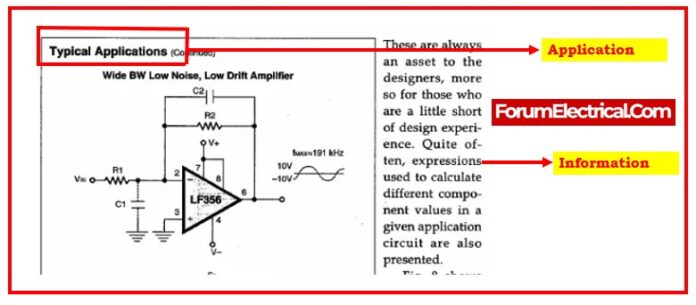- Contents of a Datasheet?
- 1). Summary (or) General Description
- 2). Specifications
- 3). Pinouts (or) Pin Connection Diagrams
- 4). Timing Diagrams
- 5). Schematics
- 6). Absolute Maximum and Minimum Ratings
- 7). Application Information
- 8). Recommended Operating Conditions
- 9). Truth Tables (or)Typical Performance Characteristics
- 10). Physical Dimensions
- 11). Ordering Information
- 12). Packaging Information
- Graphs and Charts of the Datasheet
A datasheet is an overview that helps the reader know the capabilities of an instrument. Datasheets are equivalent to a vehicle’s torque specification; they must be followed because failing to do so may result in failure to achieve the objectives.
It describes the functions, characteristics, and usage of the device. However, regardless of how helpful they are, they can also be very difficult to understand. Datasheets contain a lot of highly technical information because they are created by engineers for other engineers.
Datasheets come in a variety of forms and names, including
- Manual,
- User manual,
- Datasheet,
- Specifications,
- Info card, and
- Product overview.
Contents of a Datasheet?
In general, datasheets have an established structure with sections describing the
- Characteristics,
- Specifications,
- Pinouts, and
- Package information of the device,
- Functional block diagram, and
- Some example circuits.
Data sheets help designers and manufacturers simplify projects by easily referencing the components’ features and attributes. Data sheets vary, but most include the following sections:
1). Summary (or) General Description
2). Specifications
3). Pinouts (or) Pin Connection Diagrams
4). Timing diagrams
5). Schematics
6). Absolute Maximum and Minimum Ratings
7). Application Information
8). Recommended Operating Conditions
9). Truth Tables (or) Typical Performance Characteristics
10). Physical Dimensions
11). Ordering Information
12). Packaging Information
1). Summary (or) General Description
An overview of the functions and specifications of the component is given in the summary.
2). Specifications
The numbers that specify the requirements & capabilities of the device are listed on the specifications page.
3). Pinouts (or) Pin Connection Diagrams
The pins of the component are listed along with their locations and functions.
4). Timing Diagrams
Provides a definition of signal timing connections: how data is transferred and at what speed it should be sent & received.
5). Schematics
Demonstrates circuits employing the component with example diagrams.
6). Absolute Maximum and Minimum Ratings
Lists the
- Minimum and maximum permissible supply voltages,
- Power consumption,
- Input currents,
- Storage,
- Operating, and
- Soldering temperatures,
among other parameters.
7). Application Information
This page should provide extensive descriptions of pin functionalities, instructions on how to interface with the part, and command lists.
8). Recommended Operating Conditions
These conditions could contain
- Voltage and function ranges,
- Time information,
- Temperature ranges,
- Bus addresses, and
- Other valuable performance data.
9). Truth Tables (or)Typical Performance Characteristics
Truth tables demonstrate how different inputs effect distinct component outputs.
10). Physical Dimensions
Minimum/average/maximum dimensions, contact locations, and sizes are typical.
11). Ordering Information
Lists the various ordering codes for different packages.
12). Packaging Information
Specifies the dimensions of the various packaging options for a component: information that is quite helpful.
Graphs and Charts of the Datasheet
In the same method that a picture is worthwhile a thousand words, graphs and charts may effectively convey a substantial quantity of complicated data in a very little amount of space. It is likely going to be necessary to make use of these data in order to determine vital specifications that are not included in the standard list (or) in absolute maximum ratings.
Schematics of common application circuits may often be included in datasheets, which can be very useful for figuring out bills of materials (BOM) for auxiliary parts and for better understanding how a part works. ‘Application Notes,’ which will contain more application-specific information, are typically referred to in datasheets if do not include application-specific information.






















